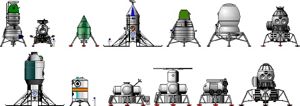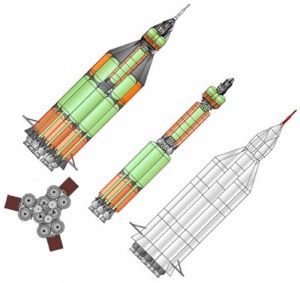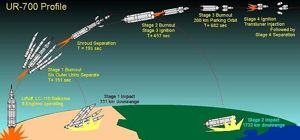
Home - Search - Browse - Alphabetic Index: 0- 1- 2- 3- 4- 5- 6- 7- 8- 9
A- B- C- D- E- F- G- H- I- J- K- L- M- N- O- P- Q- R- S- T- U- V- W- X- Y- Z
LK-700
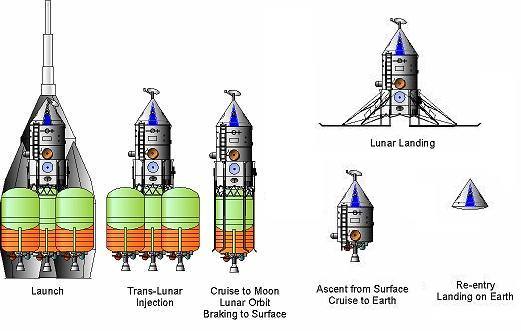
LK-700
Appearance of the LK-700 spacecraft at each phase of its direct lunar landing mission.
Credit: © Mark Wade
Status: Mock-up 1964. Thrust: 131.40 kN (29,540 lbf). Gross mass: 154,000 kg (339,000 lb). Specific impulse: 326 s. Height: 21.20 m (69.50 ft). Span: 2.70 m (8.80 ft).
The LK-700 was Chelomei's direct-landing alternative to Korolev's L3 manned lunar landing design. It would have used the monster UR-700 booster to send a crew of three on a direct flight to the lunar surface and back. Although Korolev's N1-L3 design was selected in 1964 for the manned lunar landing, work on the UR-700/LK-700 continued in parallel at a low level.
Chelomei's TsKBM began work on the UR-700 launch vehicle for manned lunar landing missions in 1962. Variants were studied with 70 to 175 metric tons payload, and rocket stages of various thrust levels, including nuclear stages. The conclusion was reached that a direct lunar landing would require a payload of 130 to 170 metric tons. Initial LK-700 spacecraft designs were derived from the 'Raketoplan' family of manned modular space vehicles. Although Korolev's N1-L3 design was selected in 1964 for the manned lunar landing, the project quickly encountered delays and weight growth. A revised UR-700/LK-700 design was presented on 16 November 1966 to an expert commission headed by Keldysh as an alternative to Korolev/Mishin's N1-L3 lunar lander project. Although Chelomei had lined up the support of Glushko, and Mishin was in a weak position after Korolev's death, Keldysh managed to ensure that the N1-L3 continued. However continued design work on the LK-700, the UR-700 booster, and development of the RD-270 engine were authorized. Chelomei took a sound conservative design approach (i.e. no docking required, no cryogenics) with the capability for evolutionary later improvement (propellant utilization system, 'hot' backup engines). The design directive documents were signed by Chelomei on 21 July 1967.
Development of the LK-700 manned lunar landing spacecraft was undertaken in accordance with decree 1070-363 of the Soviet Ministers and Central Committee of the Communist Party on 17 September 1967 and MOM decree 472 of 28 September 1967. Study index number 4855CC by TsNIIMASH in 1966 showed that any development of improved versions of the N1 would be practically equivalent to design and qualification of a new rocket, while the UR-700 modular approach allowed a range of payloads without requalification. The UR-700/LK-700 combination could support the DLB lunar base better, as well as Venus/Mars manned flybys and Mars landing expeditions.
It was planned that a total of 16 prototype articles of the LK-700 would be built for: component qualification test, dimensional fit test, static test, functional mock-up, ECS test, thermal test, module interface test, landing gear trials, antenna deployment test, SAS launch escape system test, impact and sea recovery trials, engine test, heat shield trials, and crew training.
A total of five ship-sets of UK-700/LK-700 flight articles were to be built. Two unmanned flights were to be followed by three manned flights.
Project plan was as follows:
- October-November 1968: Beginning of serious engineering work requiring external financing
- October 1968 to January 1973: Engineering design and drawing release
- 2nd Quarter 1969: Selection of cosmonaut training group
- 4th Quarter 1969: Completion of prototype article design
- 2nd Quarter 1970: Completion of flight article design
- Beginning 1971: Completion of LK-700 prototype tests
- April 1971 to April 1973: Flight crew training
- November 1971: Delivery of first LK-700 fight article. Subsequent deliveries in April, July, October 1972 and January 1973
- October 1971: Delivery of first UR-700 launch vehicle. Subsequent deliveries n February, May, August, November 1972.
- May 1972: First UR-700/LK-700 unmanned launch. Subsequent unmanned launches in November 1972 and April 1973
- April 1973: First manned UR-700/LK-700 launch. Subsequent manned flights in August and October 1973.
- Dosimetric measurements of space radiation
- Micrometeoroid environment
- Solar and cosmic radiation
- Surveys of the lunar surface, including landing site selection, development of a selenographic co-ordinate system, establishment of navigation parameters
- Measurement of the magnetic field of the moon
- Mineralogical survey of the surface
- Passive seismic observations
- Lunar surface temperatures
- Gravitational field measurement and variations
- Solar plasma
- Televised scientific observations
- Gamma spectrometer reading of the chemical composition of the surface
- Residual magnetic pole
- Laser reflector position observations
Following initial LK-700 landings the LKE Lunar Expeditionary Complex would be delivered to the surface. This would permit long duration investigations of the surface and a much wider range of research. Precision landings in support of the LKE and lunar base would use Ye-8 Lunokhods equipped with radio homing beacons. The complex would be delivered in two to three UR-700 launches:
- Launch 1: Heavy Unpiloted Station - a one-way flight to deliver a __ metric ton lunar station to the surface.
- Launch 2: LK-700 spacecraft with crew. The LK-700 would provide return transportation and was capable of being placed in dormant mode for a month.
- Launch 3: Lunar laboratory / Heavy Lunokhod would be landed to provide mobility for surface expeditions.
The later DLB lunar base would require 80 metric tons per year of payload delivered to the surface starting in 1975, followed by 150 metric tons per year after 1980. Versions of the UR-700/LK-700 could handle this more easily than modifying the N1.
Lunar versions of the Almaz OPS would be placed in lunar orbit to conduct detailed reconnaissance of the surface using manned assistance. The OPS would also be used as a command post to co-ordinate the work of lunar surface operations and organize rescues in the case of emergencies on the surface.
Although mock-ups were built, no financing for full scale development was forthcoming by the required October 1968 date. By then it was apparent, that barring some disaster with an Apollo spacecraft, the moon race was lost. Kremlin interest in supporting such projects waned.
Following the explosion of the first N1 in January 1969, Pilyugin was called to a meeting at the Kremlin. Chelomei was again proposing the use of his UR-700/LK-700 in the place of the N1-L3, and a flight to Mars using an even larger version of the launch vehicle. Afanasyev was preparing a decree along these lines. Pilyugin refused to participate in this 'adventure'.
Nevertheless Chelomei's bureau continued to study the design until 1974, when the project was finally and definitively suppressed with the cancellation of the N1 and the lunar base projects.
Technical Description
The RKS Rocket-Space System was designed for direct landing on the moon without docking in earth or lunar orbit. It consisted of:
- LK-700 spacecraft
- UR-700 launch vehicle
- Launch complex for the UR-700
- Technical positions which would take factory-completed modules and conduct assembly and check-out operations before moving them to the pad for launch
- Command-tracking system
- Crew landing and rescue system
- Crew recovery system
- The direct landing scheme would allow development of a simpler and more reliable lunar expedition system, while allowing landings at any point over 88% of the visible surface of the moon and a much wider launch window for a given mission energy. No docking was required. The N1-L3 / Apollo lunar orbit rendezvous technique limited sustained lunar surface operations to a small region around the lunar equator (due to the one month lunar period of rotation, other locations would have to wait two weeks before the companion spacecraft in lunar orbit came over the landing site again).
- N2O4 / UDMH storable propellants used universally in all stages of the launch vehicle and spacecraft.
- High reliability would be obtained in all portions of the system by minimizing the number of parts.
- Earliest possible date for the landing would be achieved by using proven systems, requiring a minimum of new hardware development. Minimum modifications of existing UR-100 and UR-500 engines were used in the upper stages. Use of the same equipment in all stages of the launch vehicle and spacecraft wherever possible.
- Crew of no less than two for the initial mission in order to provide mutual support during lunar surface operations. A crew of three would be possible on later missions after a better launch vehicle propellant utilization system was put into operation.
- All elements of the system would be completed, tested, and certified flight ready in the factory before being shipped to the launch site. No requirement for construction facilities at the launch site.
- The design would have reserve capacity to allow a range of propellant loading. This meant that a wider range of launch windows, landing sites, and flight trajectories would be available without having to redesign the launch vehicle and spacecraft. Later a wider range of landing points, return times, and so on were possible by a heavier vehicle (with completely fuelled tanks) or by adding propellant cross-feed features (topping up the central ascent stage tank with residual propellant from the lateral landing stage tanks).
- Safety of the crew was assured throughout the mission through use of double or triple redundant systems and the use of the next rocket stage in the series for maneuvers in case of the failure of a lower stage
- The complex could be easily adapted for a wide range of missions. For example, the launch vehicle payload could be increased by stretching the propellant tanks. This would allow addition of an airlock and lunar surface shelter to the lander for extended exploration missions. Other possibilities were a stretched re-entry capsule for increased number of crew, and transport variants.
- Block 1 Translunar Injection Stage: This consisted of three identical stages clustered around the core. Total mass of 103,474 kg (three rocket stages of 34,491 kg each). Each stage was equipped with a 23,500 metric ton thrust Kosberg 11D23 engine.
- Block 11 Midcourse maneuver/lunar braking stage: Mass 32,226 kg (similar to the three Translunar injection stages clustered around it). 2,041 kg of propellant used for mid-course corrections prior to the start of the lunar braking maneuver. The remainder of the propellants were used to brake the spacecraft to 30 m/s at 4.3 km above the lunar surface, at which point this stage was jettisoned. This stage differed from the lateral Block 1 stages in having an engine unit for orientation of the assembly. It was equipped with a single Kosberg 11D23 main engine of 23.5 metric tons thrust, surrounded by three Isayev 11D416 engines of 1.67 metric tons thrust for midcourse maneuvers and orientation of the spacecraft during the braking maneuver.
- Block 111 Soft Landing Stage: Mass 3500 kg. The unique soft landing platform consisted of six landing gear, each equipped with long ski-like landing pads. This design could accommodate safe landings at vertical velocities of up to 5 m/s; lateral velocities of 2 m/s; and provide a level launch platform on 15 degree slopes. Before launch of the ascent stage special electric devices in each gear would level the platform.
- Block 1V Trans-earth injection / midcourse maneuver stage:: 11,670 kg (mass 2,675 kg without propellant). This stage, using the Block 11 as a launch platform, launched the VA return capsule onto the trans-earth trajectory. It also contained spacecraft avionics and life support systems not in the VA re-entry capsule. It was equipped with a single Isotov (Klimov) 15D13 main engine of 13.4 metric tons thrust, surrounded by three Isayev 11D416 engines of 1.67 metric tons thrust for soft landing on the moon and midcourse maneuvers.
- Block V VA Re-entry Capsule: Mass 3,130 kg. This 'gumdrop' Apollo-shaped capsule was similar to that developed by Chelomei for the LK-1 translunar spacecraft and TKS manned ferry. With a hypersonic lift to drag ratio of 0.35 the capsule could maneuver during re-entry at 11 km/ s to a landing on Soviet territory. Within the VA were the crew cabin, the drogue and main parachute systems, reaction control system for stabilizing the spacecraft during re-entry, and a separable heat shield. Two lunar spacesuits were stored in the cabin for donning prior to moonwalks. The cabin could be depressurized for two to four hours at a time. On the nose of the VA was a parabolic antenna for communications, television transmission to earth, and high rate telemetry transmission.
- Block V1 ADU abort tower. This solid propellant launch escape tower was available from 1.5 hours before launch to 193 seconds into the flight to pull the VA capsule away from the launch vehicle in case of a booster failure. During the first 120 seconds of flight, the ADU would pull the VA away from the booster without its heat shield. From 120 to 193 seconds, the heat shield would remain attached to the VA. At 193 seconds into the flight four explosive bolts separated the ADU from the VA and small solid rocket motors pulled it away from the booster. Thereafter aborts would use the LK-700's Block 1V engine. The abort system was developed by NIITI.
The mission profile for the typical Sea of Fertility 8.3 day mission with a crew of 2 was:
- Insertion of the 154,000 kg spacecraft into a 186 x 260 km earth parking orbit, orbital inclination 51.5 degrees. Five hours (3.75 revolutions) would be spent in parking orbit before the translunar injection maneuver. During this time the crew check out all systems, including the radio altimeter for the critical lunar landing maneuver. The KIK tracking stations conduct precision tracking to refine the orbit of the spacecraft and the data was uploaded to the spacecraft navigation system, which included a gyroscopic platform and a stellar orientation system. The restartable orientation engines of the Block 11 stage provide orientation and ullage for starting of the Block 1 stage. 3,000 kg of consumables were used during the parking orbit phase.
- Translunar injection maneuver of 3,170 to 3,185 m/s delta v. The starting mass of the spacecraft was 151,000 kg. After translunar injection, the three lateral stages of the Block 1 were jettisoned.
- Spacecraft mass now 50,526 kg. 2,041 kg of propellant and consumables were used in spacecraft orientation and two midcourse correction maneuvers during the 3.32 day coast to moon (coast time 6.3 days for an Ocean of Storms mission). The spacecraft was tracked from KIP stations in Yevpatoriya, Shchelkov, Ussuriysk, and Sary Shagan, for six to fourteen hours each day.
- Begin lunar braking maneuver using the Block 11 stage at an altitude of 200 to 500 km (depending on the landing site) above the lunar surface. Mass of spacecraft 48,485 kg at start of maneuver. The Block 11's 11D23 engine shut down when the radio altimeter indicates velocity of 30 m/s at 4.3 km above the surface. The Block 11 stage was jettisoned.
- The 11D416 engine of the LK-700 Block 111 lander stage ignites 4.3 km plus or minus 1 km above the lunar surface. Mass of the spacecraft was now 18,300 kg. 1176 kg of propellant were allocated for the final soft landing maneuver of about 120 seconds duration. During the maneuver the radio altimeter system was used to throttle the engine and keep the center of mass of the spacecraft on the vertical. Mass landed on the moon 17,124 kg.
- Immediately after landing the crew checks out the spacecraft's systems and determine the precise position of the landing. The crew spends 12 to 24 hours on the surface, conducting two moonwalks of 2 to 2.5 hours duration each. On the surface scientific instruments were set up. 10 kg of lunar soil and movie film of the expedition were to be returned to earth with the crew.
- Trans-earth injection was conducted directly from the lunar surface, using the landing gear of the 3,500 kg Block 111 as a launch stand. The Block 1V stage's ascent maneuver consisted of 4 to 6 seconds vertical ascent at maximum thrust, followed by throttle-back; a further and 8 to 25 seconds (depending on landing site) of vertical climb; followed by a pitch-over to the velocity vector required for the return to earth. Total delta v was 2,740 to 2,840 m/s. Mass of the spacecraft on trans-earth trajectory was 5,805 kg. 4.0 days was spent on the earth return trajectory with two midcourse corrections planned.
- Re-entry into earth's atmosphere was on a hyperbolic trajectory with perigee of 50 km. The radio altimeter came into service again to update the spacecraft's position from 1,000 km to 250 km above the earth. The Block 1V stage separated at 150 km altitude after orienting the VA capsule at the correct angle for re-entry into the atmosphere at 100 km altitude. The VA used its hypersonic lift to drag ratio of 0.35 to limit G-forces on the crew during re-entry. The lift allowed it to vary its landing point from 6,000 to 11,000 km from the atmosphere entry point and from 300 km to the left or right of the ballistic course.
Crew Size: 2. Orbital Storage: 45 days. Spacecraft delta v: 9,061 m/s (29,727 ft/sec).
Family: Lunar Landers, Moon. Country: Russia. Engines: 8D423. Spacecraft: LK-700 Block 1, LK-700 Block 11, LK-700 Block 111, LK-700 VA, LK-700 Block 1V. Launch Vehicles: UR-700. Propellants: N2O4/UDMH. Agency: Chelomei bureau. Bibliography: 191, 26, 288, 367, 376, 429, 443, 474, 72, 73, 74, 6656.
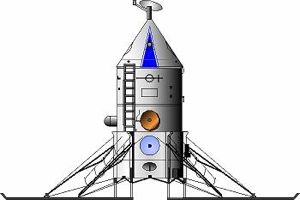 | LK-700 Spacecraft LK-700 Spacecraft with landing stage and landing gear deployed. Credit: © Mark Wade |
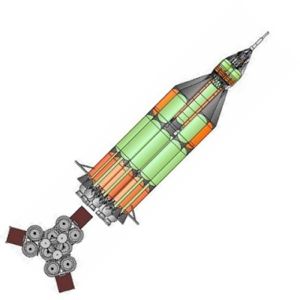 | UR-700 UR-700 Launch Vehicle for Direct Lunar Landing Mission Credit: © Mark Wade |
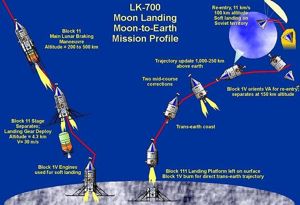 | LK- 700 Profile 2 Credit: © Mark Wade |
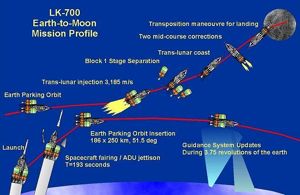 | LK-700 Profile 1 Credit: © Mark Wade |
1962 During the Year - . Launch Vehicle: UR-700.
- Development of RD-270 engine begun - .
Nation: Russia.
Related Persons: Chelomei,
Yangel.
Program: Lunar L3.
Class: Moon.
Type: Manned lunar spacecraft. Spacecraft Bus: TKS.
Spacecraft: LK-700.
The RD-270 engine was proposed for Chelomei's UR-700 and Yangel R-56 lunar landing launchers in competition to Korolev N1. The RD-270 was in the same class as the F-1 engine developed for America's Saturn V launch vehicle, but burned storable but toxic propellants.
1962 During the Year - . Launch Vehicle: UR-700.
- UR-700 launch vehicle for manned lunar landing missions. - .
Nation: Russia.
Related Persons: Chelomei.
Spacecraft Bus: TKS.
Spacecraft: LK-700.
Chelomei's TsKBM began work on the UR-700. The conclusion was reached that a direct lunar landing would require a payload of 130 to 170 tonnes. Initial LK-700 spacecraft designs were derived from the 'Raketoplan' family of manned modular space vehicles. Korolev's N1-L3 design was selected in 1964 for the manned lunar landing, but the UR-700 would surface again when the N1 encountered delays.
1964 September 24 - . Launch Vehicle: N1.
- Khrushchev visits Baikonur - .
Nation: Russia.
Related Persons: Belyayev,
Brezhnev,
Chelomei,
Gagarin,
Glushko,
Khrushchev,
Korolev,
Leonov,
Smirnov,
Ustinov,
Yangel.
Flight: Voskhod 2.
Spacecraft: Berkut,
LK-700,
Voskhod.
This was his last visit, just weeks before his overthrow. The Soviet leadership were shown the UR-100 and observed launches of the competing UR-200 and R-36. Khrushchev agreed with the decision to put the R-36 into production instead of Chelomei's UR-200. He felt he couldn't turn down Yangel a third time after approving Korolev's N1 instead of Yangel's R-56 and Chelomei's UR-100 instead of Yangel's R-26. Khrushchev decided to cancel Korolev's badly behind schedule R-9A, even though Smirnov and Ustinov insisted they wanted it in their arsenal (in May 1965, after Khrushchev's overthrow, this decision was reversed and the R-9A went into production).
Khrushchev also visited a secret space fair, with Korolev, Chelomei, Yangel, and Glushko presenting their rockets and spacecraft. Chelomei presented his UR-700 heavy lift design as an alternative to Korolev's N1. This presentation was a surprise to Ustinov and Dementiev. Khrushchev ordered Chelomei to prepare a draft proposal for the design. Chelomei hoped that 12 to 18 months later, when the UR-700 draft project would be completed, the fallacy of Korolev's N1 design would be apparent to all. Korolev's N1 plans were also reviewed and approved at the meeting.
Over the two days, Khruschev witnessed five launches of rockets by Korolev, Yangel, and Chelomei, all of them successful. Gagarin and Belyayev explained the Vykhod spacecraft to him, and Leonov donned a spacesuit and demonstrated how he would exit into open space form the inflatable airlock and return thereafter. All went very well.
This was the last time Khrushchev saw the chief designers of the Soviet rocket industry. Despite his support for them not one of them visited him in his retirement.
1964 October 31 - . Launch Vehicle: UR-700.
- UR-700 project cancelled - .
Nation: Russia.
Related Persons: Chelomei,
Korolev.
Program: Lunar L3.
Class: Moon.
Type: Manned lunar spacecraft. Spacecraft Bus: TKS.
Spacecraft: LK-700.
Following the August decree that gave the circumlunar project to Chelomei and the lunar landing project to Korolev, further work on development of the UR-700 by Chelomei was cancelled. However development of the RD-270 engine was continued and Chelomei continued to do UR-700 design studies.
November 1964 - .
- Korolev's admits that N1 cannot attain payload needed for single-launch mission - .
Nation: Russia.
Related Persons: Babakin,
Brezhnev,
Chelomei,
Khrushchev,
Korolev,
Kozlov,
Lavochkin,
Ustinov,
Yangel.
Program: Lunar L3.
Spacecraft: LK,
LK-700,
Soyuz 7K-LOK.
Korolev speaks privately to Chertok. Kozlov has told him it will be impossible to build an N1 with the 93 tonne payload capability until the fourth flight article. The L3 concept was still the same as in the August decree - 2 cosmonauts aboard the LOK orbiter, one aboard the LK lander. Korolev asks Chertok to take 800 kg out of the weight budget for the L3. Chertok informs him that they are already 500 kg over the August budget. This is still without all the unknowns of the automated lunar landing being solved. Additional Details: here....
1965 October 20 - . Launch Vehicle: UR-700.
- Draft project work on UR-700/LK-700 approved. - . Nation: Russia. Spacecraft Bus: TKS. Spacecraft: LK-700. Ministry of General Machine Building (MOM) Decree 'On approval of work on the draft project of the UR-700/LK-700 lunar complex' was issued..
1966 September 17 - .
- Competing lunar landing designs to be evaluated. - . Nation: Russia. Spacecraft: LK, LK-700, Soyuz 7K-LOK. Military-Industrial Commission (VPK) Decree 'On creation of a commission to compare the UR-700-LK-700 and the N1-L3' was issued..
1966 November 16 - .
- Government go-ahead for N-1 use in lunar program - .
Nation: Russia.
Related Persons: Chelomei,
Keldysh,
Mishin.
Program: Lunar L3.
Class: Manned.
Type: Manned spacecraft. Spacecraft: LK-700,
Soyuz 7K-LOK.
Mishin's draft plan for the Soviet lunar landing was approved by an expert commission headed by Keldysh. The first N-1 launch was set for March 1968. At same meeting, Chelomei made a last ditch attempt to get his revised UR-700/LK-700 direct landing approach approved in its place. Although Chelomei had lined up the support of Glushko, and Mishin was in a weak position after Korolev's death, Keldysh managed to ensure that the N1-L3 continued. However continued design work on the LK-700, the UR-700 booster, and development of the RD-270 engine were authorised.
1966 December 28 - . Launch Vehicle: UR-700.
- Almaz and LK-700 development status - .
Nation: Russia.
Related Persons: Chelomei,
Smirnov,
Ustinov.
Program: Almaz,
Lunar L1,
Lunar L3.
Spacecraft: Almaz OPS,
LK-1,
LK-700,
Raketoplan.
Kamanin accompanies 17 generals and other officers of the VVS in a tour of Chelomei's OKB-52. Chelomei spends five hours personally acquainting the visitors with his bureau's space technology capabilities. It was the first in-depth meeting Kamanin and Vershinin have had with Chelomei, despite meeting with him occasionally since 1961. They have mainly interacted with Korolev and now Mishin. Additional Details: here....
1967 July 21 - . Launch Vehicle: UR-700.
- Chelomei signs design documents for UR-700/LK-700 lunar expedition - . Nation: Russia. Related Persons: Chelomei. Spacecraft Bus: TKS. Spacecraft: LK-700. Chelomei's TsKBM began work on the UR-700 launch vehicle for manned lunar landing missions in 1962. Chelomei took a sound conservative design approach (i.e. no docking required, no cryogenics)..
1967 September 17 - . Launch Vehicle: UR-700.
- LK-700 manned lunar landing spacecraft authorised - .
Nation: Russia.
Spacecraft Bus: TKS.
Spacecraft: LK-700.
Development of the LK-700 manned lunar landing spacecraft was undertaken in accordance with decree 1070-363 of the Soviet Ministers and Central Committee of the Communist Party on 17 September 1967 and MOM decree 472 of 28 September 1967. Study index number 4855CC by TsNIIMASH in 1966 showed that any development of improved versions of the N1 would be practically equivalent to design and qualification of a new rocket, while the UR-700 modular approach allowed a range of payloads without requalification. The UR-700/LK-700 combination could support the DLB lunar base better, as well as Venus/Mars manned flybys and Mars landing expeditions. Work would continue through the mock-up stage until 1974.
1967 September 20 - .
- Review of N1 progress. - .
Nation: Russia.
Related Persons: Mishin,
Pashkov,
Smirnov,
Ustinov.
Program: Lunar L3.
Spacecraft: LK-700,
Spiral OS.
The booster was supposed to be launched by 1966, but there is no way it will be finished this year, and it is highly questionable it will even get off the ground in 1968. The N1 tanks are pressurised to 2 atmospheres, and can go up to three atmospheres in an emergency. In the enormous MIK assembly hall are three N1's - one 'iron bird' ground test model and two flight vehicles. The first roll out of the mock-up will take place in 1967, and the first launch attempt is still expected in 1968 (the first launch will not be attempted until the second and third stages complete stand tests. There is no test stand for the first stage, it will be fired for the first time in flight). An explosion would destroy the pad, requiring several years of repairs. There are two pads, but even that would not be a guarantee of the availability of the rocket due to the poor expected initial reliability. The N1 project is costing 10 billion roubles, not including considerable investment required by the military. To Kamanin the whole thing is a boondoggle, showing the necessity for development of lighter air-launched boosters. He believes there are many mistakes in design and construction, but Mishin, Pashkov, Smirnov, and Ustinov support these doubtful projects of Korolev and Mishin, instead of technically sound projects such as Chelomei's UR-700 or MiG's air-launched spacecraft. If Mishin thinks the current Proton/L1 reliability is only 0.6, then that of the completely unproved N1/L3 must be even less...
1970 December 31 - . Launch Vehicle: UR-700.
- UR 700/LK-700/RD-270 definitively cancelled. - . Nation: Russia. Program: Lunar L3. Class: Moon. Type: Manned lunar spacecraft. Spacecraft Bus: TKS. Spacecraft: LK-700. Further development work on the RD-270 engine, UR-700 launch vehicle, and LK-700 lunar landing project are cancelled following the successful Apollo lunar landing..
1971 March 4 - .
- N1/L3 Expert Commission - .
Nation: Russia.
Related Persons: Keldysh,
Kuznetsov, Nikolai F,
Mishin,
Tereshkova.
Program: Lunar L3.
Spacecraft: Krechet,
LK-700,
Soyuz 7KT-OK.
Pushkin and Kuznetsov brief Kamanin on the results of the N1/L3 expert commission. They found that the N1/L3 is unreliable and that the design needs to be fundamentally re-examined. Therefore the Soviet Ministers and Central Committee passed a decree that the commission must determine by 1 May 1971 what to do with the lunar project. Kamanin's opinion: abandon the N1-L3, modify Chelomei's UR-700 design to replace it, and design a new lunar landing spacecraft for missions in 1974-1975. Mishin is afraid of such a solution. Kamanin believes that the commission, headed by Keldysh, will finally recommend continued development and flight of Mishin's bad booster and even worse spacecraft. It is true that the N1 design has been substantially reworked in the last 18 months, but Kamanin believes it to be fundamentally flawed and that nothing can make it reliable.
After Mishin pushed his Indian Ocean recovery plan for the L3, the VVS insisted on sea trials of the capsule. These showed the cosmonauts had to get out within 30 to 35 minutes before the valves to the interior started leaking seawater. The L3 is also unsafe due to the EVA method of transfer to the LK of a single unassisted cosmonaut. The Krechet spacesuit is very bulky and unmanoeuvrable.
Prague wanted Gagarin's widow for International Women's Day.since Tereshkkova couldn't go, but she wants no part of public appearances.
Back to top of page
Home - Search - Browse - Alphabetic Index: 0- 1- 2- 3- 4- 5- 6- 7- 8- 9
A- B- C- D- E- F- G- H- I- J- K- L- M- N- O- P- Q- R- S- T- U- V- W- X- Y- Z
© 1997-2019 Mark Wade - Contact
© / Conditions for Use
